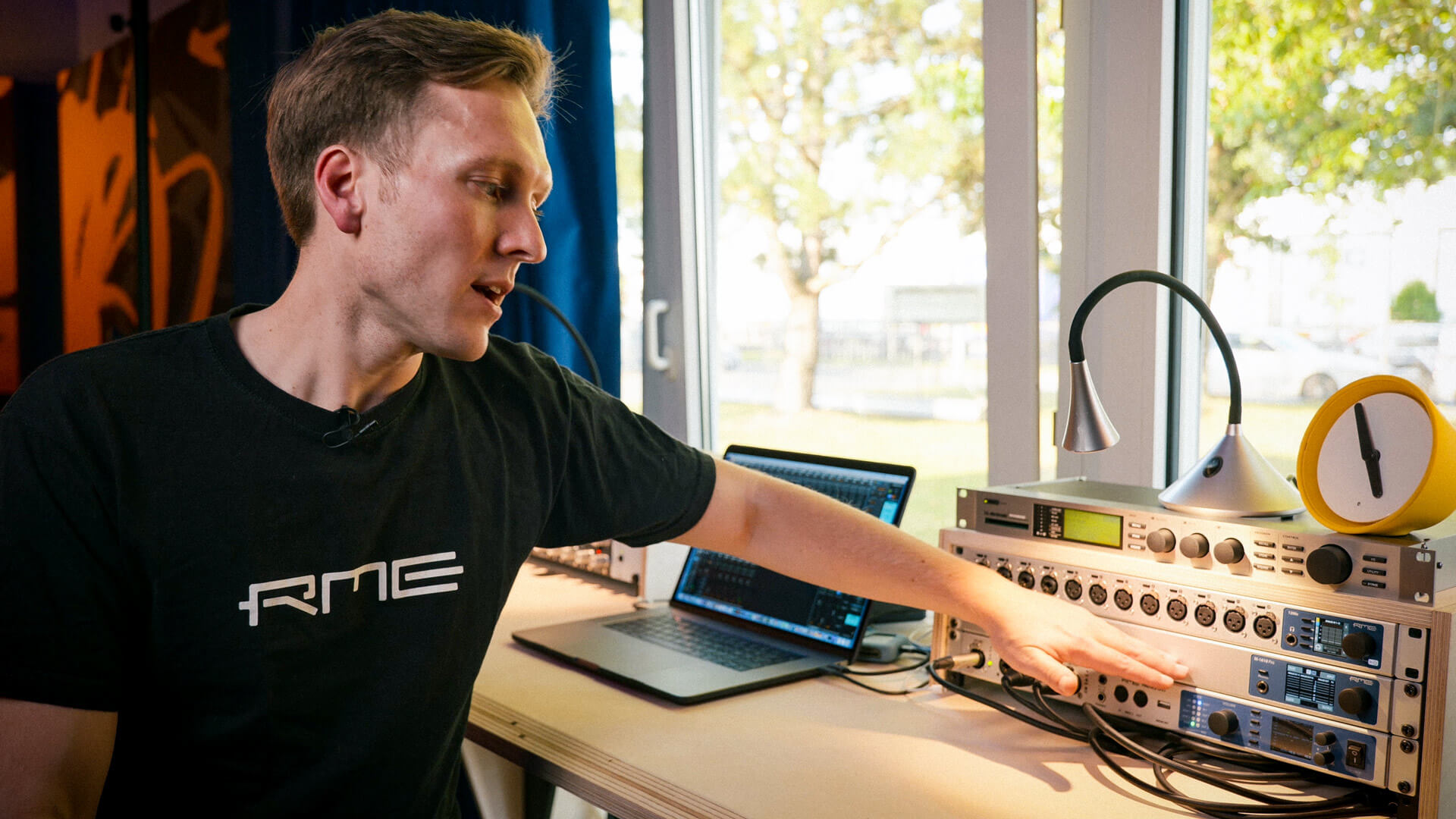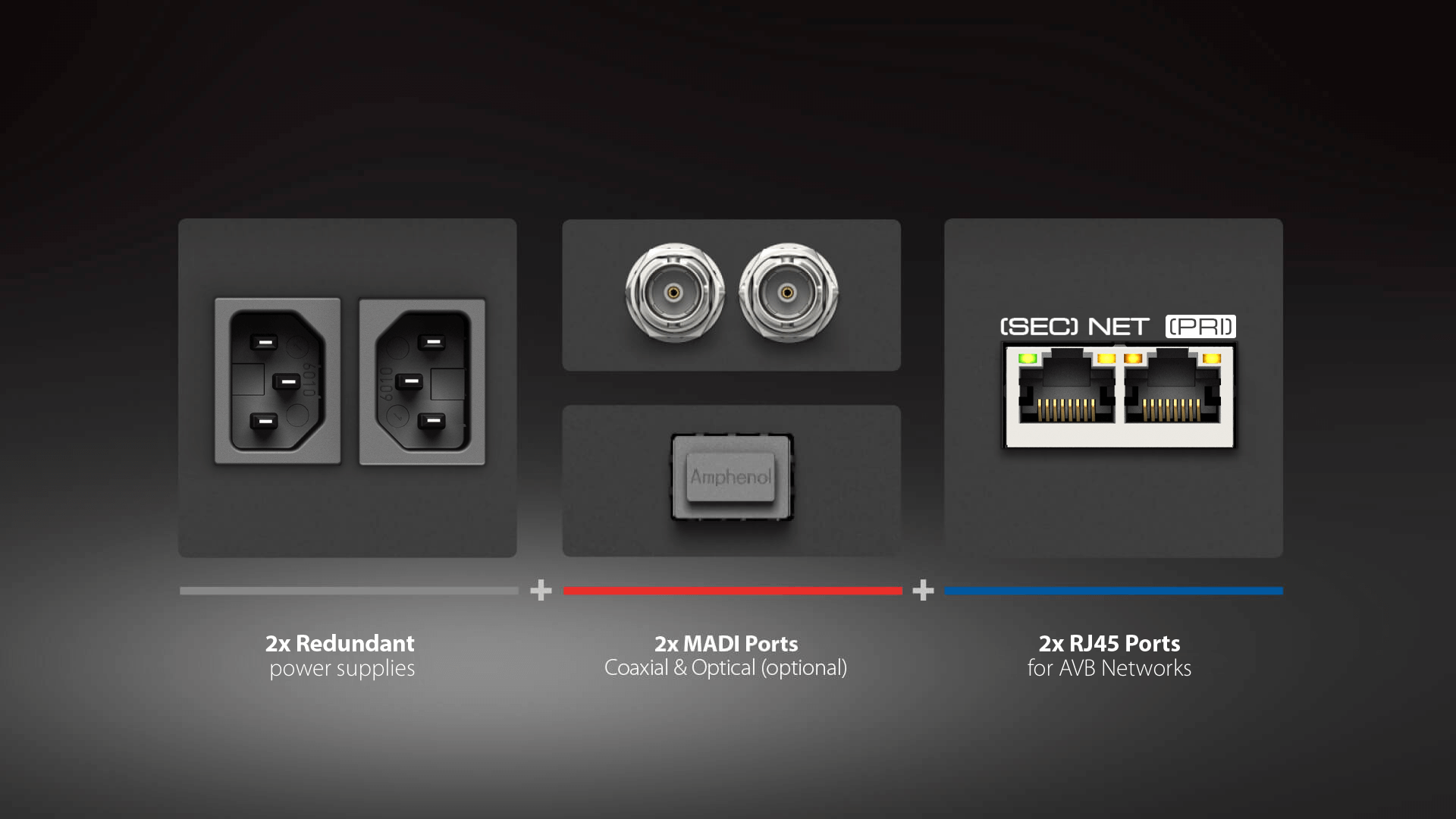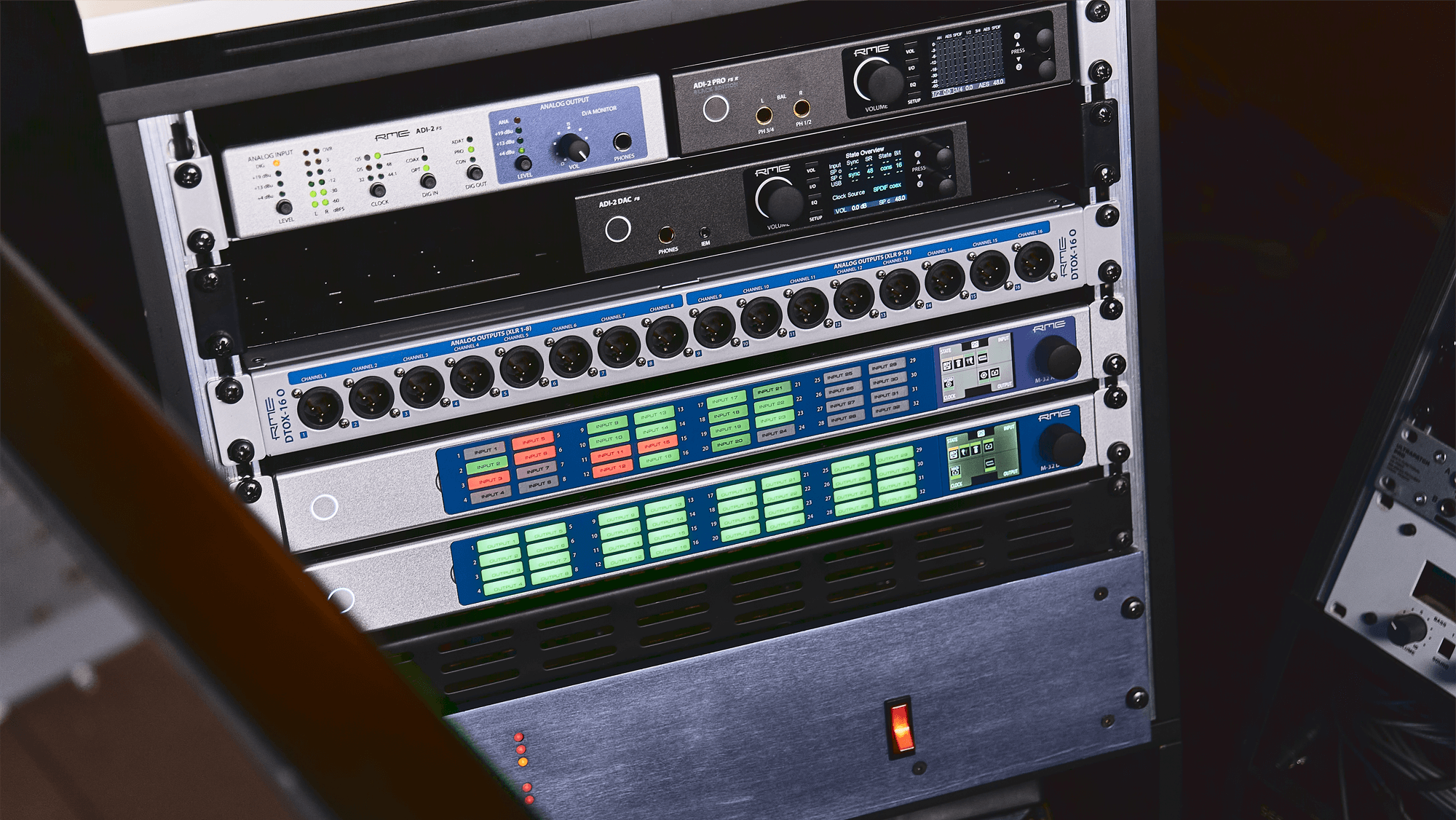M-32 AD / M-32 DA Pro II
High-end 32-Channel 192 kHz AD or DA Converter with MADI and AVB


Conexiones y características
The Ultimate Solution for High-End Network Audio Processing
The latest 32-channel M-32 Pro II is based on state-of-the-art, high-resolution converter components and a fully balanced analog circuit design that offer signal-to-noise ratios of 120 dB(A) with very low latencies — placing the converters in the reference class. While the M-32 AD Pro II offers the same outstanding analog performance as its predecessor, the DA-Converter has even improved the THD+N to -111 dB. All models benefit from impulse response optimization at sampling rates of 88.2 kHz and higher to minimize ringing artifacts in the conversion process.

AVB Network Solutions by RME Audio
Plug & play - rapid user interaction
Control all device states directly from the front panel for convenient, direct access to all features. RME AVB devices can be reached over network (including wirelessly over Wi-Fi) and USB for convenient remote access, allowing the rapid creation of gain groups, phantom power switching and clock configuration. In addition, a JSON based API and even SysEx MIDI commands can be used to integrate each model virtually anywhere. The integrated routing matrix allows single channel routing across all analog and digital I/O. As such, problem-solving of signals, clocking, connectivity or other issues is both simple and straight-forward!

Direct access to all features via the web-interface on any network
AVB Audio Networking - 2 fully redundant network ports
In addition to the two MADI I/Os including separate signal routing, the new M-32 DA Pro II and M-32 AD Pro II feature an AVB interface based on the open network standards IEEE 802.1 and 1722.1, enabling transmission of the 32 analog channels at a maximum 192 kHz sampling rate via a single Ethernet cable. Combined with external AVB switches, the new M-Series converters can be quickly, easily and reliably integrated into more complex network structures thanks to the comprehensive time-synchronous signal processing of the AVB protocol. Up to 128 audio channels at 48 kHz (96 @ 96k, 64 @ 192k) can be sent and received over AVB in total across all streams.
RME offers an AVB device with two fully redundant network ports, based on the recommendations of MILAN™. The RME AVB Core has meticulously implemented the IEEE standards for audio- streaming, discovery and control, allowing RME devices to be both discovered and fully controlled by any AVB controller, and making vendor-specific control protocols a thing of the past. Any signal reaching the M-32 Pro II can be routed and streamed over a network with fixed latency and guaranteed bandwidth - no switch configuration is required!

Multiple layers of redundancy make the M-32 Pro II Series a perfect companion for any kind of live sound application.
Analog Line Level Performance
For maximum compatibility with a variety of analog hardware, the individual channels of the M-32 AD Pro II and M-32 DA Pro II can be operated with different line levels - each with full resolution of the converters. Besides +19 dBu and +13 dBu, the new M-Series is one of the few solutions available on the market that also allows working with the SMPTE® recommendation of +24 dBu at 0 dBFS.

Available as AD or DA version for unprecedented flexibility and compatibility in format conversion.
Easy to Operate
Tri-color back-lit channel label fields offer an almost indispensable advantage in fixed installations. Using the provided transparent papers, users can create individual channel labels and securely affix them behind a magnetic cover, where they are illuminated depending on signal level. This provides a comprehensive overview of analog channel assignments and signal flow.
Updates included
With hardware built to last, RME makes sure the firmware running on the device does not fall behind. Since the release of the first version of the M-32 Pro, numerous feature updates have been released, delivering an increase of AVB total stream and channel count from four streams (64 channels) to nine streams (128 channels + additional CRF clock stream), additional stream formats, numerous adjustments for MILAN™ compatibility, single channel routing, preset upload and download, configurable preset names, static IP address assignment, and many more. They reflect the ongoing commitment of RME developers to sound engineers that expect the best performance of their devices for years to last.
About MADI - Multi Channel Digital Audio Protocol
MADI is a protocol that has evolved alongside RME to be the most widely accepted multi channel digital audio protocol on the market. RME’s MADI-based systems deliver incredible reliability, particularly in applications where failure is not an option.
Accesorios
Optical MADI SFP Module (optional available)
This module extends compatible RME devices with an optical SFP transceiver. Up to 64 audio channels can then be sent to and received from other MADI devices. THE RME SFP module is available in a Multi-Mode and in a Single-Mode version, it can be inserted and removed while the RME MADI device is powered on. It is not necessary to power down the device.
Especif
M-32 AD / M-32 DA Pro II
- 32 x Analog In/Out (25-pin D-sub, up to +24 dBu)
- 2 x MADI I/O (via optional available optical SFP and coaxial BNC, up to 128 Ch.)
- 2 x RJ45 1 GigE AVB, four streams with 4/8/12/16 Ch. each
- (optional) MIDI I/O for legacy MIDI Remote
- Word Clock I/O (BNC)
- USB 2.0 (for remote control)
- 2 x monitored fully redundant internal PSUs
- 32-channel AD converter, fully symmetrical design, 120 dBa
- 19” enclosure 1 unit height
- Large, tri-color backlit channel indicators with Peak/RMS metering
- Magnetic cover with customizable channel labels
- SyncCheck® and ICC® - detects when a clock source is not in sync and falls back to other available signals
- MADI Auto-Input - seamless redundancy
- 2” display with control knob for full device control
- 15 Preset storage, firmware upgrade persistent
- Lock (optional code) and dark mode
- Internal single channel routing of up to 288x256 (M-32 AD Pro II) / 256x288 (M-32 DA Pro II) channels (32 x Analog, 64 x MADI Opt, 64 x MADI Coax, and 128 x AVB)
- Remote control via HTTP, JSON, IEEE 1722.1 ATDECC, MIDI over MADI and optional MIDI
M-32 Pro II AD Line In 1-32:
- Resolution: 24 bit
- Input level switchable per channel +24 dBu, +19 dBu, +13 dBu @ 0 dBFS
- Inputs AC coupled, fully symmetrical signal path (servo-balanced)
- Input Impedance 9.5 kΩ
- Signal to Noise ratio (SNR) @ +24 dBu, 44.1 kHz: 117.0 dB RMS unweighted, 120.7 dBA
- Signal to Noise ratio (SNR) @ +19 dBu: 116.3 dB RMS unweighted, 119.9 dBA
- Signal to Noise ratio (SNR) @ +13 dBu: 114.7 dB RMS unweighted, 118.3 dBA
- Frequency response @ 44.1 kHz, -0.1 dB: 5 Hz – 20.5 kHz
- THD @ -1 dBFS: < -111 dB, < 0.00029%
- THD+N @ -1 dBFS: < -108 dB, < 0.00039 %
- Channel separation: > 110 dB
M-32 Pro DA II Line Out 1-32:
- Resolution: 24 bit
- Output level switchable per channel +24 dBu, +19 dBu, +13 dBu @ 0 dBFS
- Outputs DC coupled, fully symmetrical signal path ("truly balanced")
- Output impedance: 200 Ohm balanced, 100 Ohm unbalanced
- Signal to Noise Ratio (SNR) @ 13 dBu: 116.0 dB RMS unweighted, 119.0 dB(A)
- Signal to Noise Ratio (SNR) @ 19 dBu: 116.3 dB RMS unweighted, 119.3 dB(A)
- Signal to Noise Ratio (SNR) @ 24 dBu: 116.5 dB RMS unweighted, 119.8 dB(A)
- Frequency response @ 44.1 kHz, -0.1 dB: 0 Hz – 22 kHz
- THD @ -1 dBFS: < -113 dB, < 0.00022 %
- THD+N @ -1 dBFS: < -111 dB, < 0.00028 %
- Channel separation: > 110 dB